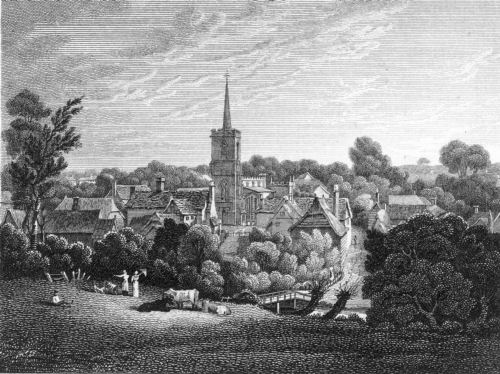|
|
Braughing in the Early 19th Century |
 |
From Braughing, Hertfordshire Engraved by W. Wallis from a Sketch by F. W. L. Stockdale for the Antiquarian Itinerary Published for the Proprietors June. 1. 1815 by W. Clarke, New Bond Street.
|
BRAUGHING, called Brachinges in the Domesday Book, was ancient demesne of the Saxon Kings, and was given by the Conqueror to Earl Eustace; but on his rebellion in the next reign, it was seized by William Rufus; and afterwards remained in the Crown till the time of King Stephen, who granted lands here, of the yearly value of 100s. to the Church of the Holy Trinity, in London, in perpetual alms. This grant was confirmed by the Empress Maud, who bestowed the remainder of the manor on the same foundation; and it continued attached to it till the period of the Dissolution, when Henry the Eighth granted it to the Lord Chancellor Audley; but it has since passed through a variety of families. The weekly market, which had been granted to the Canons of the Holy Trinity, by Stephen, has been long disused.
The Church at Braughing is a handsome building, consisting of a nave, chancel, and aisles; with a Chapel, now divided into a School-room, and Vestry, on the north side of the chancel. This Chapel was erected by Simeon Brograve, Esq. son and heir of Sir John Brograve, Knt. of Hamells, as a family burial-place; and round it, on the inside, is this inscription: Hæc Capella fuit extructa propriis sumptibus SIMEONIS BROGRAVE, Arm. Domini Manerii de HAMELLS, in locum Sepulturæ pro mortuis dictæ Domus et per Dominum dicti Manerii sustinenda perpetuoque reparanda. Gloria Patri et Filio et Spiritui Sancto. In this Chapel, many of the Brograves lie buried. Various memorials for other families appear in different parts of the Church.
Salmon supposes Braughing to have been the Cæsaramagus of the Itinerary, but on very insufficient grounds, and he has not been supported by other authorities. His strongest argument is deduced from an ancient Encampment, traces of which may be distinguished to the south of the village, on a rising ground above the confluence of the Rib and the Quin. Not any discoveries, however, have been made here to justify his supposition of its ever having been occupied by the Romans.
from
The Beauties of England & Wales:
Hertfordshire
by John Britton
1807
Page created December 2008